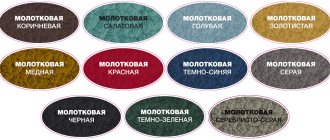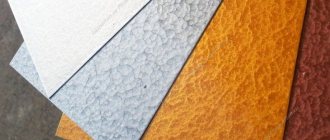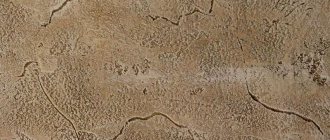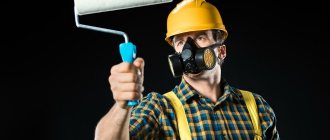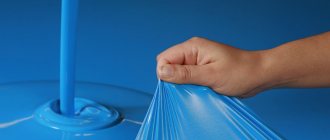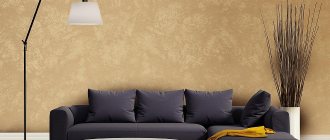Painting various structures makes it possible not only to get a beautiful color on the surface, but also often solves the issue of creating an additional level of protection from external factors. Among the usual liquid painting solutions, hammer paint stands out, which leaves a strong barrier on the surface; on a metal base, high-quality protection against rust is obtained, as well as a beautiful decorative layer. How the composition differs from other paints and how to use it will be discussed below.
What is hammer paint
The material got its name for its relief texture, reminiscent of embossing. It is also called blacksmith paint (enamel). Available in cans and jars.
Composition characteristics
Basic set of components:
- Nitrocellulose, alkyd, epoxy or acrylic enamel. This is the base of the paint.
- Aluminum flakes and defatted powder (non-floating), glass chips, zinc phosphate, silicon-based organic compounds: silicone oil, petroleum jelly, rubber. This is a filler that acts as a pattern-former.
- Mineral or organic pigment to impart color.
- Solvents – ketone and paraffin compounds.
The aluminum filler gives the coating strength and, together with organic additives, changes the surface tension. This leads to the formation of a hammer effect due to the curvature of the outer film.
To maintain its integrity, it is necessary to ensure that the aluminum stays closer to the substrate (does not float up). For this purpose, it is degreased.
In addition to the listed components, others may be present in the composition. They do not affect the characteristics and are mainly used by manufacturers to promote products on the market.
Scope of application
Hammer enamel was created for harsh operating conditions. It is painted with:
- Production and laboratory equipment exposed to chemical and mechanical factors, vibration, temperature and humidity changes.
- Industrial structures located on the street.
- Means of transport.
The non-standard appearance led to the use of hammer enamels “for other purposes” – as a decorative coating. It is used to paint safes, artistic forging items and other products with high aesthetic requirements, benches, fences, gates and wickets.
Forge enamel goes well not only with metals. It covers wood, ceramics, plastic, etc.
Industrial structures located on the street are painted with hammer enamel.
Types of hammer paint
The following types of coatings are produced:
- powder;
- liquid.
The second option is the most common. Alkyd paints are most often purchased.
The following domestic brands have confirmed their quality through many years of use:
- NTs-221. Relatively inexpensive nitrocellulose-based enamel. It is not moisture resistant and is intended for interior use only.
- ML-165. Alkyd-styrene based coating. It is characterized by heat resistance (up to +130°C) and high adhesive strength. Suitable for outdoor use, can be applied to rust (contains converters).
- EP-1323ME. Epoxy based composition. It also has high adhesion, heat and moisture resistance. Suitable for all types of work.
Among imported ones, Hammerite alkyd paint has the greatest durability. The material can be applied to rusty surfaces. Its disadvantage is its high cost.
Advantages and disadvantages
Hammer enamel for metal has the following advantages:
- Resistant to extreme temperatures and sudden changes. The most heat-resistant versions can withstand heating up to +300°C.
- Anti-corrosion effect.
- Increased strength.
- Ability to neutralize rust.
- Short drying time. Aerosol paint has the lowest indicator.
- Moisture resistance.
- Durability. The paint lasts 8 years, color brightness lasts 3 years.
- No harmful fumes. The material is suitable for use in residential premises.
- Aesthetic qualities.
- Color variety.
- Dirt- and water-repellent effect.
- Low requirements for the evenness of the painted surface. The relief texture of the paint smoothes out defects.
- Maintainability. If there is damage, the product does not need to be completely repainted. The coating is restored only on the damaged area, after which the defect becomes invisible.
- Vibration resistant.
- Good hiding power (the ability to paint over the color of the base).
- Resistant to weather conditions, oil, weak alkalis and acids.
Flaws:
- Lack of plasticity. Microcracks may appear in the corners, allowing moisture to pass through to the metal.
- Increased consumption. The average is 100 g/m2.
- High price.
- Difficulty with removal. The material is difficult to peel and solvents.
- Possibility of rust spreading from unpainted areas to enamel.
Moisture resistance is one of the advantages of paint.
Color palette
The first versions of blacksmith's enamel had only black, white or gray colors, since they were used in industry for purely utilitarian purposes. Later, when the decorative qualities of the material were appreciated and the demand for it increased, stamps with different pigments began to be produced. The following options are available:
- golden;
- copper and bronze;
- silver;
- blue, blue, violet;
- green, khaki;
- red, brown, chocolate.
The best manufacturers
In Russia, the following companies and enterprises are engaged in the production of hammer effect paints:
- "TEX" (St. Petersburg).
- Group . He is the owner of the KUDO trademark.
- "NPP Rogneda". Owner of TM Dali.
- "KrasKo" (Moscow). They produce Molotex enamels.
- . Owner .
- . Manufactures products under .
- TH "LAKRA". Launches Parade Z1 hammer enamel.
The most popular among foreign ones are:
- Hammerite (UK).
- Permo (Finland).
- Alpina (Germany).
- Dufa (Germany).
Hammerite is a popular foreign brand of hammer paint.
Which brush is suitable
A brush is used as a classic method to paint surfaces. It helps to paint hard-to-reach places, but the choice of hammer paint must be made correctly. Regular bristles can crumble when in contact with a similar composition, so it is important to choose high-quality bristles that will withstand painting and will not leave elements on the surface.
It is important to choose high-quality bristles that will withstand painting and will not leave elements on the surface.
What affects operation
While aluminum filler is added to other paints to impart gas and water resistance, heat resistance and other properties, in blacksmith paint it primarily performs a decorative function. Performance characteristics depend only on the enamel, which acts as a base.
Powder hammer paints
Powder paint is applied with a spray gun. At the same time, a static charge is imparted to it, while the product to be painted is connected to the pole of a direct current source. As a result, particles are held on the surface due to electrical attraction.
Next, the product enters a special oven where the coating is sintered.
This type of paint is characterized by increased resistance to mechanical stress. But with prolonged use in the open air, its structure is destroyed under the influence of ultraviolet radiation. As a result of the photochemical activity of the pigment, areas of erosion are formed around it. This process is called chalking. A sign is a change in the gloss of the coating. Damaged areas are chipped under mechanical stress, which leads to loss of strength and protective properties of the coating.
Liquid enamel
The performance characteristics of liquid paint are influenced by the following factors:
- Condition of the base. The inscription in the characteristic “enamel against rust” is interpreted by some as a lack of requirements for surface preparation. Preliminary removal of loose oxides will greatly extend the service life of the coating and increase adhesion strength. The material does not adhere well to smooth surfaces. It is sanded before painting.
- No greasy stains on the surface to be painted. This also has a positive effect on grip strength. Particular attention is paid to treating new products with a degreaser: they are often coated with factory lubricant.
- Primer. It is allowed to apply enamel directly to a metal surface. But pre-treatment with a primer will greatly improve its performance characteristics.
Advantages and disadvantages
Hammer paint would not have become as popular as it is now if it did not have characteristics other than its spectacular appearance.
The demand for the composition is explained by the following useful qualities:
- Resistant to temperature changes. The paint does not lose its properties and does not crack when heated to + 80 degrees; it is not afraid of the most severe frosts.
- No pre-treatment of surfaces before applying the dye.
- Possibility of applying paint directly to rust.
- Mechanical strength.
- Resistant to precipitation and moisture.
- Drying speed. Aerosol paints take first place in terms of speed of setting; they completely harden within a couple of hours after being applied to the surfaces of parts.
- The ability to provide protection to metal products from corrosion. The minimum shelf life of the protective layer on external structures is 8 years.
- No negative consequences during operation. There are no harmful fumes when heated.
- Restoring the consumer properties of corroded items.
- Wide range of colors.
After the paint dries, the surface of the products acquires the ability to repel dust. The appearance of such products is always neat; they do not need to be constantly wiped.
Disadvantages of blacksmith's dye include:
- Difficult to remove. No modern solvent can quickly cope with a durable coating. To remove it you will have to work hard. In this case, the solvent will only soften the paint; it will have to be removed mechanically using a scraper or abrasive tool.
- Corroded by rust. If you miss a small area, the coating runs the risk of being “eaten” by rust. Corrosion will appear on unpainted metal over time. Gradually it will spread to the dye itself.
- Inability to use a spray gun when working with thick enamel.
- High paint consumption.
- High price.
Drying time
Information about how long the paint takes to dry is given in the instructions for use. On average, this takes 2 hours, after which the coating ceases to be sticky. But the enamel gains maximum strength after 2-3 days.
After painting the car, it is recommended to refrain from operating it during this time.
The influence of these factors depends on the manufacturer. Thus, Dali enamel from NPP Rogneda can be applied to stainless steel and non-ferrous metals without a primer. Hammerite products do not hold up well under these conditions.
Advantages
Painting with hammer paint is a reliable and durable way to prevent damage to products from rust and weathering. Thanks to its composition, enamel has a number of advantages:
- Resistant to atmospheric changes and temperature changes (withstands up to +80 degrees).
- Universal, used for various types of surfaces.
- Easy to use, as it can be applied with a brush, spray gun, roller, or spray gun. Painting on wood can be used without prior priming, as well as on rust. Due to its consistency, it does not form smudges.
- Hammer paint is characterized by the fact that the painted surface sets within 40 minutes, dries in 2 hours, and complete drying occurs within a day. This is especially important for a car when painting it.
- Hammer paint for metal for exterior work can be used in windy weather, that is, there is no need to drive the car into a box.
- Unlike most paints and varnishes, this dye does not have a strong odor. After complete drying, the paint is completely harmless to the human body.
- A wide range of colors allows it to be used for interior decoration and exterior work. It comes in glossy and matte. The paint has a characteristic metallic sheen. It does not fade over time. You can view the colors on special pallets provided by the manufacturers.
- Long service life - warranty up to 8 years, but in practice longer.
- The availability of high-temperature and fire-resistant types of hammer paints significantly expands the scope of application. For example, for painting safes.
- Cleans well and is resistant to household chemicals.
Another characteristic of hammer paint is that, due to its structure, it hides individual small surface defects.
How to prepare a surface for painting
Before applying hammer paint to metal, it is subjected to the following types of processing:
- Use a brush with metal bristles or an abrasive tool to remove loose rust, burnt marks, scale, and peeling old paint. There is no need to completely remove the finish.
- If the surface is smooth, it is roughened using an abrasive tool: sandpaper, a drill with a special attachment, or a grinder with a grinding disc.
- Treat the product with a degreaser, for example white spirit, solvent (petroleum solvent) or “No. 646”. Then - acetone. You can wash it with washing powder, then rinse with clean water and dry. The absence of greasy stains is checked by applying a napkin or filter paper to the surface: there should be no traces on them.
The remaining old paint is tested for compatibility: enamel is applied to a small area and after a few hours the coating is examined for defects and adhesion. If the result is unsatisfactory, the previous finish is completely removed.
Before painting, the surface must be treated with a brush with metal bristles.
Gate painting
Painting gates with hammer paint is the most common type of finishing, since the material has proven itself well on vibrating surfaces. This means that paint is often used to coat moving metal structures. How to paint a gate with hammer paint? For painting, the same technology is used as when applied to other surfaces. The effect will be better if applied using a spray gun.
The color spectrum allows you to create a decorative effect. For example, paint the first two layers with black enamel, then highlight individual elements with white. Gates painted with hammer paint look quite impressive.
Technology of painting metal with hammer paint
There are several ways to apply enamel. The choice depends on the surface configuration and its area. In each case, you need to know how to paint correctly, otherwise the coating will be short-lived.
Using a brush
This method provides the most pronounced hammer effect. Paint with a brush:
- Small areas.
- Small elements with complex shapes belonging to large products.
- Furniture, frames and other items with high aesthetic requirements.
It is recommended to place the product horizontally. Thus, the metal door will have to be removed from its hinges. If this is not possible, use a quick-drying version of enamel.
Use a brush with natural bristles. Synthetic enamel is corroded by the solvents contained in the enamel.
The number of layers depends on the orientation of the surface:
- horizontal – 2;
- vertical – 3.
It is necessary to make sure that there are no untreated areas left on the product. Otherwise, any rust on them will spread to the paint.
Apply undiluted enamel with a brush.
Construction roller
This tool can be used to paint large, flat surfaces, such as a gate or cabinet wall. Use a short-haired tool made of the following materials:
- velor;
- fur.
Foam rubber is not suitable for the same reason as a synthetic brush: the solvents included in the paint corrode the polymers.
The enamel is applied in 2-3 layers. For the first, it is diluted with a solvent recommended by the manufacturer (1/9 of the paint volume). For alkyd mixtures, xylene and solvent are used in this capacity in most cases.
Small parts of complex configuration are pre-treated with a brush.
Use a roller to paint large, flat surfaces.
Aerosol spray
Use a spray can to paint:
- small items, such as artistic forging items;
- chips and other damage.
In the second case, you should first make sure that the paint shade matches the base coating.
Follow the rules:
- The sprayer is held at a distance of 15-20 cm from the surface to be painted.
- Shake periodically.
- Apply 3-4 thin layers. After the first, there is a pause of 3 minutes, then 20.
Pneumatic spray gun
This method is used for painting large surfaces, incl. relief. Skills in working with a spray gun and the ability to set it up correctly are required.
Follow the rules:
- The enamel is diluted with a solvent (1/7-1/8 of the paint volume). It is advisable to ensure the viscosity recommended by the manufacturer by monitoring it with a viscometer.
- Painting is done in 2-3 layers, the first one is made as thin as possible.
- Provide temperature within +18…+22°С.
Recommended settings:
- Pressure – 2.5-3.5 atm.
- Nozzle diameter – 3-4 mm.
- Spray cone angle – 65°.
The spraying method is characterized by the greatest losses - up to 50%.
Spray
This equipment is also designed for processing large flat and embossed surfaces. It carries out airless spraying of paint. The master must have the appropriate skills and know the required parameters to properly configure the spray gun. The application technology repeats the actions with a spray gun.
The spray gun carries out airless spraying of paint.
Scope of application
The scope of application of the dye is determined by its characteristics. Hammer paint has the ability to resist rust. Therefore, first of all, it is in demand for coating metal products and only then everything else.
The following look perfect in hammer “clothes”:
- garage gates, entrance doors, gates and fences;
- casings of various moving mechanisms;
- cabinets containing electrical equipment;
- building structures, supports, fastenings;
- equipment and laboratory instruments;
- metal parts of park benches, garden furniture;
- safes and safe deposit boxes intended for storing valuables;
- forged jewelry;
- car parts.
Hammer enamels have transcended traditional limitations. Today they are used for processing wood, ceramics, hard plastic and glass.
Blacksmith's dye appears in all its glory when applied to a horizontal surface. This means that to paint a door or garage door, you need to remove it from its hinges, return it to its original horizontal position, and only then begin processing.
Paint that is resistant to fading and temperature changes is often used in the design of outdoor advertising structures. Durable coating is found on home furnishings made in high-tech, loft, and Provence styles.
Instructions for painting some surfaces
When applying enamel with your own hands, you must avoid untreated areas. It is useful to consider the procedure using the example of the most complex and massive structures.
Painting metal gates
It is recommended to remove the sashes and place them on stands made of bars. Then proceed like this:
- Use an abrasive tool or a wire brush to remove any loose old paint. The rest needs to be scraped together. If the coating does not fall off, then it can be left.
- Treat the sash with solvent or a similar degreaser, then with acetone.
- Cover the surface with a primer. Due to the high adhesive force, hammer enamel holds well even without this, but in the case of gates and doors, it is better not to ignore this stage.
- Dilute the paint with a solvent in the proportion corresponding to the selected tool (roller or spray gun).
- Apply the composition with a brush to the corners, hinges and edges of the product. If there are eyes for a padlock, they are also treated.
- Using a suitable tool, apply the enamel to the main surface. After drying, the product is repainted 1 or 2 times.
The last layer is made thick so that there are no drips on the gate.
Car coverage
Painting a vehicle has its own characteristics. If the rules are followed, a textured “alligator skin” pattern is achieved. The recommendations are as follows:
- No primer is used. Instead, the surface is carefully prepared and defects are filled with putty. After drying, it is sanded.
- The paint is applied in 2 layers with a break between them of 30 minutes.
- It takes 7 hours to dry completely.
- After 3 days they begin to operate the vehicle.
In the absence of experience, it is not recommended to dilute the enamel; it is better to use a ready-made composition of the required consistency. Knowledgeable craftsmen use solvents:
- For steel products – Rustbeater no1.
- For non-ferrous metals – Special Metals Primer.
By correctly using the solvent, a more pronounced decorative effect is achieved.
The diameter of the spray gun nozzle is 4 mm. The VZ-246 viscometer is suitable for determining the viscosity of enamel. The preferred tools are a roller or brush. They create a more pronounced relief and an attractive metallic sheen.
Painting can be done in the garage. For stable operation of the spray gun, the household compressor should be equipped with a 200 liter receiver.
When painting a car, the paint is applied in 2 layers with a break between them of 30 minutes.
How to paint a car
How to paint flat surfaces is quite clear, but how to apply paint to a car? First of all, you need to prepare tools and materials:
- directly hammer enamel;
- short-haired roller or spray;
- solvent No. 647;
- enamel primer;
- abrasive material.
Attention! Prepare all the necessary items in advance; they should be nearby, as they may be needed at any moment. The enamel dries very quickly, so there is no delay in working with it.
Although blacksmith paint does not require preliminary priming, experts still recommend doing this to achieve the highest quality of painting.
Stages of staining:
- Clean the parts and vehicle from dirt and dust.
- Degrease surfaces with special solutions.
- If there is severe rust, get rid of it. To do this you will need abrasive paper (sandpaper). Even if there is no rust, still use sandpaper, since the enamel adheres better to a rough surface, plus adhesion increases.
- A rust converter can be used to remove large areas of corrosion. If you bought Hammerite enamel, then don't worry about corrosion. Because paint contains substances that coat rust.
- Treat the surfaces with primer-enamel, which must first be diluted.
- Now pour the paint into a construction ditch and dip the roller into it. When it is soaked, roll it over the ribbed surface of the cuvette. Or get your spray gun ready for use.
- Then you can paint large surfaces. After applying the first coat, wait 30 minutes before applying the second coat.
Complete drying of the mixture is achieved after seven hours, but it is permissible to operate the machine only after three days. You can cover the last layer with regular varnish. This will improve the decorative qualities of the painted surface.
Important! The glossy coating of the car must be removed - the paint does not adhere to such a surface, only to a matte one.
Recommendations for coloring
The work is carried out in compliance with the following conditions:
- First, study the instructions to determine at what temperature you can paint with this composition. In most cases, the range +10…+30°С is indicated. The optimal value is +20…+25°С.
- The maximum permissible humidity is 70-80%.
- Painting is carried out outdoors or in a ventilated area. In the first case, the weather must be calm, otherwise the enamel will become covered with dust. Choose a place protected from direct sunlight so that drying occurs in natural conditions.
- There should be no open flame sources nearby.
- Use personal protective equipment.
- After work, the tool is cleaned of paint with a solvent.
- To make the embossed pattern more pronounced, apply several layers with a brush or roller. The total thickness does not exceed 100 microns, otherwise the enamel will take a long time to dry.
- A spray gun and spray gun are used in cases where a decorative effect is not required.
- The surface is not leveled using putty. Small cracks and scratches are filled with paint, thanks to its texture they will become invisible.
- It is not allowed to apply enamel to coatings containing bitumen or made using the powder method.
- Before painting, wood is treated with water-based acrylic primer. Otherwise, the porous material will absorb the enamel.
How to choose a solvent
Before thinning hammer paint, you need to select a suitable thinner. The solvent should be selected based on the manufacturer’s recommendations, which are indicated on the packaging. For conventional formulations, toluene or xylene is used.
You cannot use solvents other than those specified by the manufacturer for Hamerite paint. A special diluent has been developed for this composition, which helps improve the properties of the composition. Other products created to dilute paints may worsen the result.
The solvent should be selected based on the manufacturer’s recommendations, which are indicated on the packaging.
Making hammer paint
For homemade enamel you need ingredients in the following proportions:
- UVL-1 varnish – 96.8%.
- Aluminum shavings – no more than 6%.
- Soot – 0.5% (gives shade and relief).
- Silicone oil.
Preparation is carried out in a warm room. All components, except silicone oil, are unloaded into a container and mixed first with a stick, then with a construction mixer. The mixture is brought to a homogeneous state. In a properly prepared solution, aluminum shavings do not float.
Finally, add 5-8 drops of silicone oil. To add a tint, you can add colored enamel, but not more than 30% of the total mass.
Advantages and disadvantages
Compared to other coloring compositions, hammer coating has a number of advantages:
- resistance to humidity, temperature changes and heating up to 80°C;
- quick drying;
- immunity to vibrations - this allows the coating to be applied to the surface of various industrial equipment, garage doors and other domestic buildings;
- anti-corrosion properties that last for 8 years;
- if painting for rust is expected, then the preparatory work is simplified, since thorough cleaning and priming are not necessary;
- the absence of an unpleasant odor and safety for health allow this type of coating to be used for interior work;
- dirt- and dust-repellent abilities;
- various application methods (brush, roller or aerosol);
- large selection of shades and their durability;
- camouflage properties - the hammer effect of the paint hides all chips and small irregularities on the painted surface.
But this paint also has disadvantages:
- difficulties in removing the coating from the surface;
- with partial painting, there is a risk of corrosion in untreated areas, and over time, its spread to hammer enamel for metal;
- hammer coating is quite difficult to apply with a spray gun;
- high consumption and, at the same time, a fairly high price.
Special abilities
Separately, it is worth mentioning paints with a hammer effect, which are created specifically for painting radiators. Their distinctive feature is their ability to withstand high temperatures. This is usually a heat-resistant enamel with a rust-transforming effect.
Over time, this coating does not fade, does not lose color or peel off. Suitable for use on cast iron and steel structures. Many metal hammer paints for radiators contain diamond chips or diamond shine.
Metal structures are painted not only for a decorative effect. The coating should also serve as protection from environmental influences, high humidity, corrosive processes, and temperature changes. In this case, hammer paints have many advantages.
They are suitable for equipment and parts that are used in outdoor conditions. This paint contains synthetic resins that provide uniform coverage and stable protection. As for the decorative effect, hammer paints retain the original result for many years, which is why they are often used as coatings for fences and gates.
The strange name “hammer” appeared due to a specific type of dye. The surface treated with this composition does not seem smooth, but dotted with small depressions. It looks like it was shot at and then painted.
However, the authors of the name were, apparently, peaceful people and the texture reminded them of the surface after blows from a blacksmith’s hammer. The unusual name was assigned to the paint and is still used today.
